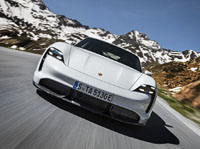
Not many cars have been as enthusiastically anticipated as the new Porsche Taycan, and now production model has finally arrived at the 2019 IAA in Frankfurt, Germany.
To say that it’s powerful seems as bizarrely understated as merely calling it quick. Take a deep breath and then consider that its most formidable variant makes an outrageous 750 horsepower and even more mind-blowing 774 lb-ft of torque, its collective force allowing for a 2.8-second blast from zero to 100 km/h.
Such performance is nothing new to Tesla aficionados, the California brand’s Model S P100D good for a 0 to 100 km/h run of only 2.6 seconds, but how it achieves that feat with just 613 horsepower and 686 lb-ft of torque available is beyond me (although the fact that its heaviest curb weight of 2,250 kg/4,960 lbs is lower than the Taycan’s 2,295-kg/5,059-lb unladen weight probably has something to do with it). Then again, Porsche has a tendency to understate performance specifications; this brewing up to be an epic drag race that every credible cable and YouTube automotive show will be covering.
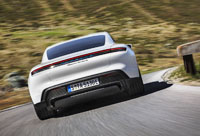
This said, Porsche’s faithful care more going fast around corners than merely burning up the asphalt in a straight line. To prove the Taycan’s dominance through tight twisting curves, Porsche took a pre-series example to the legendary Nürburgring-Nordschleife racetrack and quickly set an EV lap-record of 7:42 minutes, which just so happened to obliterate the last Tesla Model S P85D’s 8:50 lap time by over a minute. A minute off the pace around any racetrack is downright embarrassing, making us willing to bet that Tesla will soon show up in Nürburg, Rhineland-Palatinate with its more recently introduced P100D, plus a complete crew and an experienced driver.
In Tesla’s corner is price, because any 2020 Taycan Turbo is much more expensive than even a fully featured Model S P100D. The 2020 Taycan Turbo, which makes 671 maximum horsepower in launch mode, 627 lb-ft of torque, and can achieve a 3.2-second run from zero to 100 km/h, is now ready to order for $173,900 plus freight, whereas the new top-tier Taycan Turbo S is available from $213,900. Making matters more interesting, these two models aren’t even fully loaded, with Porsche’s many pricey options capable of driving its price up and over $250,000, which is a range normally associated with Aston Martin Rapides, Bentley Flying Spurs and Rolls-Royce Ghosts (ok, maybe a used R-R).
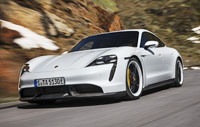
None of the super sedans above are capable of completing the 100-yard dash as quickly or scaling a mountain pass with the level of fleet finesse as a Taycan, however, while none will get the job done without chugging down a tanker’s full of premium unleaded gasoline. Back to electrics, a new 2019 Model S can be had for a comparatively bargain basement $108,990, while its sportier Performance trim line will set you back a mere $134,990 before creeping up to $155k when all options are added. Still, that seems like chump change next to a Taycan Turbo or Turbo S.
If you’re starting to feel like Porsche has forgotten simpler folk that can barely afford anything into six figures, we can take a little comfort in knowing that these super-fast Turbo variants (in name only, as there are no turbos at play) are merely being introduced first for their jaw-dropping wow factor. Later this year additional less powerful trims will be added to bring the price down from their current cirrus-pheric levels to mere stratospheric realms, but the upcoming Cross Turismo crossover coupe, which will directly take on Jaguar’s I-Pace toward the end of 2020, will no doubt have a full range of more and less accessible window stickers.
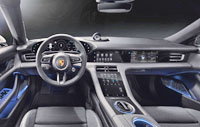
While performance matters, styling will probably play a bigger role in consumer choices when opting for either the Taycan or Model S. The new Porsche is completely new and inarguably good looking, whereas the Model S has been in production for seven years with very few changes. Fit, finish and interior refinement isn’t exactly a Model S strong point either, but expect only the industry’s best materials and workmanship within the new Porsche, while Stuttgart’s various on-board electronic systems are as good as digital displays get.
To that end the Taycan includes a fully digital pod-like gauge cluster that appears to float on its own behind the steering wheel. The black background of its classic Porsche curved oval area gets filled with colourful high-definition graphics that should appeal to both experienced EV users as well as long-time Porsche owners, while the two touchscreens that span the centre and right-side of the dash, the second display in front of the passenger, and the third capacitive touchscreen atop the sloped centre console (a la Range Rover), are digital eye candy and ideal for optimal control of the car’s myriad functions.
One of those screens no doubt includes animated power-flow graphics that show a permanent-magnet synchronous motor powering each axle, combining for the previously noted output numbers depending on the model chosen, although it should be noted that both make 616 horsepower when not in launch mode.
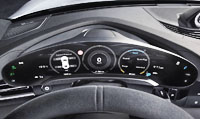
With that overboost setting switched back on, the slower of the two Taycan models can launch from standstill to 200 km/h in a scant 10.6 seconds, while this car’s standing quarter mile arrives in just 11.1 seconds. Do the same with the more formidable Turbo S and the 200-km/h mark arrives in just 9.8 seconds, while the quarter mile zips past in only 10.8. Both trims top out at 280 km/h (161 mph), an electronically limited top speed.
To achieve such performance the new Porsche incorporates some ultra-sophisticated tech, such as a single-speed front transmission and a larger two-speed rear gearbox. The latter transmission incorporates one gear for acceleration and another taller one for higher speed cruising. It chooses between rear gear sets automatically by monitoring a driver’s style, but it can also be done manually by selecting one of five drive modes. Just like it sounds, Range mode optimizes efficiency and therefore employs the taller second gear as often as possible while temporarily shutting down the front motor, whereas Normal mode makes the second gear the priority, yet uses the first gear a bit more. Sport mode, on the other hand, prioritizes first gear up to about 90 to 100 km/h, although it shifts to the second gear whenever throttle pressure is eased, and then goes back to first when needed. The Taycan also includes Sport Plus and Individual driving modes.
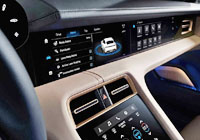
Anyone who’s owned a Tesla knows about overheating, the Model S notorious for it, especially when trying to execute consecutive full-power standing starts. Rather than grandfather this problem onto new Taycan buyers, Porsche has designed cooler running electric motors that feature a special hairpin winding technique to the stators’ copper solenoid coils. The result is a copper fill factor of 70 percent compared to 45 percent when those coils are wound the traditional way, giving the Taycan better more reliable performance.
In order to prove its point, Porsche endurance-tested the new Taycan in ultra-hot climates (of 42°C with a track temperature of nearly 54°C). A pre-production model circled Italy’s high-banked Nardò Ring oval racetrack at speeds ranging between 195 and 215 km/h for 24 hours straight, the marathon including six test drivers covering 3,425 km (2,128 m). Following up this punishing test program was another test that saw the new Porsche undergo 26 back-to-back launches from standstill to 200 km/h of less than 10 seconds each, with an average of 0.8 seconds variance between fastest and slowest acceleration times. Then we have the Nürburgring event noted earlier, with performance that should completely set the Taycan apart from the Model S.
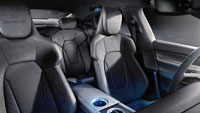
Below the floorboards of both Taycan Turbo models is a 93.4-kilowatt-hour high-voltage lithium-ion battery sourced from LG, with enough stored energy to drive for 381 to 450 km (237 to 280 miles) based on the European WLTP rating system. The more quicker Turbo S also offers more range, its expected distance from fully topped up to near empty being 388 to 412 km (241 to 256 miles).
Making all this happen is an industry-first 800-volt electrical architecture, this also providing for faster recharging when an appropriate 270-kW charge station can be found (or installed in your home). How fast can it be refilled? How does five to 80 percent in just 22.5 minutes sound? Sure that’s a long wait for those used to filling up at a gas station, but anyone familiar with an electric car will know this is incredibly quick.
Porsche’s Charging Planner makes the process of charging even easier, or at least can maximize one’s efficiency when traveling. For instance, when it charts a given route it factors in the best places to recharge along the way, even if it driving a bit farther out of the way for a quicker 270-kW charge station (which will save a lot of time over a regular 50-kW DC charger) is needed. What’s more, the Charging Planner will precondition the battery to 20°C for faster recharging.
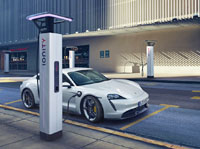
As noted earlier, the new 2020 Porsche Taycan Turbo and Turbo S are now available to build and order from Porsche Canada’s retail website, or you can place an order through your neighbourhood Porsche dealer, but you’ll want to act quickly if being amongst the first in your city to own one matters. This is the first electric car ever capable of truly taking on Tesla’s quickest Model S, making it about as important as any EV built within the last seven years.
And while waiting to take delivery of your new Taycan, or simply hoping for those lottery ticket numbers to match the bouncing balls on TV, enjoy the complete album of gallery photos above and generous supply of Porsche-sourced videos below:
Story credits: Trevor Hofmann
Photo credits: Porsche
World Premiere Porsche Taycan (40:33):
The new Porsche Taycan – Designed to enliven (1:28):
The fully electric Porsche Taycan accelerates 0-90-0 mph on the USS Hornet (0:59):
Onboard Lap – Porsche Taycan Sets a Record at the Nürburgring-Nordschleife (8:09):
New Porsche Taycan sets a record at the Nürburgring-Nordschleife (0:58):
Taycan Prototype Convinces at Endurance Run in Nardò (0:57):
The new electric Porsche Taycan proves its repeatability of power before upcoming World Premiere (1:05):
A thank you to electricity: The Porsche Taycan (0:45):
